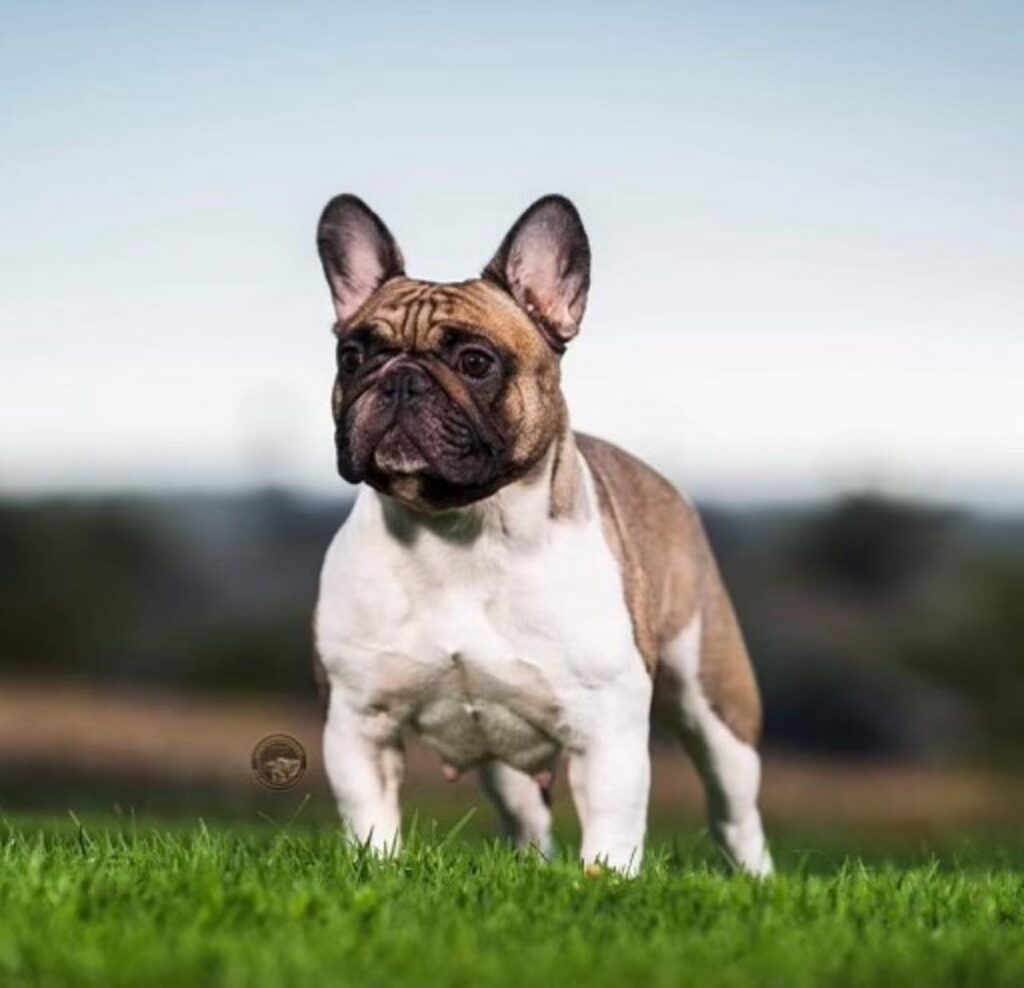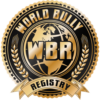
French Bulldog
A compactly built dog, the French Bulldog, in spite of his name, is believed to be at least partly of British origin. He is a descendant of the Toy Bulldog, which was bred during the nineteenth century and exported to France, where the breed became popular. In fact, English lacemakers from the Midlands who went to work in France took small Bulldogs with them. This stock is believed to have mixed with short-faced bull-baiting dogs from other European countries. This ‘new’ breed was brought to England and first shown around 1900, with a French Bulldog club being formed in 1903.
The bat ear is a distinctive feature of this breed and adds to the droll expression. He is medium-to-small-sized dog and bred in three colours – brindle, pied and fawn – with a short, easy-to-keep-clean coat.
Very intelligent and always ready for fun, the French Bulldog has an affectionate disposition. But although he has a jolly, engaging personality and is very vivacious, he is not a boisterous or a noisy dog. Comfort means a lot to him and he will happily live in house or flat as an integral part of the family.
Breed Standard
BREED ORIGIN : FRANCE
BRIEF HISTORICAL SUMMARY
Probably issued, like all the mastiffs, from the Epirus and the Roman Empire molosses, relative of the Bulldog of Great Britain, the Alans (tribe of the Middle Age), the mastiffs and small type mastiffs of France, the bulldog we know is the product of different crossings done by enthusiastic breeders in the popular quarters of Paris in the years 1880.
During that period, the Bulldog being a dog belonging to butchers and coachmen of « les Halles » (market place), he soon knew how to conquer the high society and the artistic world by his particular appearance and character. He then rapidly propagated himself.
The first breed club was founded in 1880 in Paris. The first registration dates from 1885 and the first standard was established in 1898, year in which the « Société Centrale Canine » of France recognized the breed of the French Bulldog. The first shown dog was from 1887. The standard, modified in 1931, 1932 and 1948, was reformulated in 1986 by H.F. Reant and R. Triquet (F.C.I. publication 1987), then in 1994 by the committee of the Club of the French Bulldog with the collaboration of R. Triquet.
GENERAL APPEARANCE
Typically a small size molossian. Powerful dog for its small size, short, compact in all its proportions, smooth-coated, with a short face, a snub nose, erect ears and a naturally short tail. Must have the appearance of an active animal, intelligent, very muscular, of a compact build with a solid bone structure.
BEHAVIOUR / CHARACTER
Sociable, lively, playful, sporty, keen. Particularly affectionate towards his masters and the children.
HEAD
The head must be very strong, broad and square, the skin of the head forming almost symmetrical folds and wrinkles. The head of the bulldog is characterized by a contraction of the maxillary-nasal part; the skull has taken up in width that which it has lost in length.
CRANIAL REGION :
Skull : Broad, almost flat, forehead very bulging. Superciliary arches prominent, separated by a particularly developed furrow between the eyes. The furrow must not extend onto the forehead. Occipital crest is hardly developed.
Stop : Deeply accentuated.
FACIAL REGION :
Nose : Broad, very short, turned up, nostrils well open and symmetrical, slanting towards the rear. The inclination of the nostrils as well as the snub nose (i.e. upturned) must, however, allow a normal nasal breathing.
Muzzle : Very short, broad, with concentric symmetrical folds coming down on the upper lips (length of muzzle about 1/6 of the total length of the head).
Lips : Thick, a little loose and black. The upper lip rejoins the lower lip at its middle, completely covering the teeth which should never be visible. The profile of the upper lip is descending and rounded. Tongue must never show.
Jaws : Broad, square, powerful. Lower jaw shows a broad curve, terminating in front of the upper jaw. The mouth being closed, the prominence of the lower jaw (prognathism-undershot) is moderated by the curve of the lower mandibular branches. This curve is necessary to avoid a too important shifting of the lower jaw.
Teeth : The lower incisors must never be behind the upper incisors in any case. The arch of the lower incisors is rounded. The jaw must not show lateral deviation, nor torsion. The disposition of the incisoral arches should not be strictly delimited, the essential condition being that the upper and the lower lips rejoin to completely cover the teeth.
Cheeks : The muscles of the cheeks are well developed, but not prominent.
Eyes : Lively expression, set low, quite far from the nose and especially from the ears, dark coloured, quite big, well round, slightly protruding, showing no trace of white (sclera) when the dog is looking straight ahead. Rims of eyelids must be black.
Ears : Medium size, wide at the base and rounded at the top. Set high on the head, but not too close together, carried erect. The orifice is open towards the front. The skin must be fine and soft to the touch.
NECK : Short, slightly arched, without dewlap.
BODY :
Topline : Rising progressively at loin level to slope rapidly towards the tail. This conformation which must be sought after, is the consequence of the short loin.
Back : Broad and muscular.
Loin : Short and broad.
Rump : Oblique.
Chest : Cylindrical and well let down; ribcage barrel shaped, very rounded.
Forechest : Wide.
Belly and flanks : Drawn up without excessive tuck up.
TAIL : Short, set low on the rump, close to the buttocks, thick at the base, knotted or kinked naturally and tapering at the tip. Even in action, must stay below the horizontal. A relatively long tail (not reaching beyond the point of the hocks), kinked and tapering is admissible, but not desirable.
LIMBS
FOREQUARTERS : Forelegs vertical and parallel seen in profile and from the front, standing well separated.
Shoulder : Short, thick, with a firm and visible musculature.
Upperarm : Short.
Elbows : Close to the body.
Forearm : Short, straight and muscular.
Pastern joint – Pastern : Solid and short.
HINDQUARTERS : Strong and muscular, hindlegs a little longer than the forelegs, thus raising the hindquarters. The legs are vertical and parallel as seen both in profile and from behind.
Thigh : Muscled, firm without being too rounded.
Hock joint : Quite well let down, neither too angulated nor certainly too straight.
Hock : Solid and short. The French Bulldog should be born without dewclaws.
FEET :
Forefeet round of small dimension, i.e. « cat feet », well set on the ground, turning slightly outward. The toes are compact, nails short, thick and well separated. The pads are hard, thick and black. In the brindle subjects, the nails must be black. In the pieds (caille = brindled fawns with medium white patching) and fawn subjects, dark nails are preferred, without however penalising the light coloured nails.
Hindfeet well compact.
GAIT / MOVEMENT : Free movement, the legs moving parallel to the median plane of the body.
COAT
HAIR : Beautiful smooth coat, close, glossy and soft.
COLOUR :
- Uniformly fawn, brindled or not, or with limited patching (pied).
- Fawn brindled or not, with medium or predominant patching.
All the fawn shades are admitted, from the red to light brown (café au lait) colour. The entirely white dogs are classified in « brindled fawn with predominant white patching ». When a dog has a very dark nose, dark eyes with dark eyelids, certain depigmentations of the face may exceptionally be tolerated in very beautiful subjects.
SIZE AND WEIGHT : The weight must not be below 8 kg nor over 14 kg for a bulldog in good condition, size being in proportion with the weight.
FAULTS : Any departure from the foregoing points should be considered a fault and the seriousness with which the fault should be regarded should be in exact proportion to its degree and its effect upon the health and welfare of the dog.
- Nose tightly closed or pinched and chronic snorers.
- Lips not joining in the front.
- Depigmentation of the lips.
- Light eyes.
- Dewlap.
- Tail carried high, or too long or abnormally short.
- Loose elbows.
- Straight hock or placed forward.
- Incorrect movement.
- Coat (hair) too long.
- Speckled coat.
SERIOUS FAULTS :
- Incisors visible when mouth closed.
- Tongue visible when mouth closed.
- Stiff beating movement of the forelegs.
- Pink spots on the face, except in the case of brindled fawns with medium white patching (« caille ») and fawns with limited or predominant white patching. (« fauve »).
- Excessive or insufficient weight.
DISQUALIFICATIONS :
- Aggressive or overly shy.
- Colour of nose other than black.
- Hare lip.
- Dog with lower incisors articulating behind upper incisors.
- Dog with permanently visible canines, mouth being closed.
- Eyes of two different colours (heterochromatic).
- Ears not carried erect.
- Mutilation of ears, tail or dewclaws.
- Taillessness.
- Dewclaws on hindquarters.
- Colour of coat black and tan, mouse grey, brown.
Any dog clearly showing physical or behavioural abnormalities shall be disqualified.
N.B. : Male animals should have two apparently normal testicles fully descended into the scrotum.
